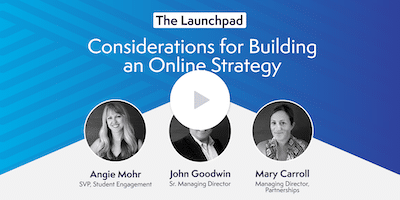How to Develop a Student Persona: Strategies and Examples
Why Student Personas Are Critical for Enrollment Marketing Success
Knowing your customer is fundamental to any successful marketing campaign. In the field of higher education marketing, this means developing a deep understanding of the students your program and/or institution is trying to reach and, ultimately, enroll.
In today’s competitive higher ed market, adopting a story-driven, persona-based approach is essential for engaging with the right prospective students. A persona-based approach not only helps to reduce acquisition costs and increase student engagement, it can further your institution’s mission while cultivating brand affinity as well.
Student personas should be used to help illustrate the prospective student’s journey in a way that will resonate with them. Good personas allow students to “see” themselves reflected in your enrollment marketing materials and make them feel welcome and understood. Ultimately, a robust student persona should always aim to answer the questions:
- Where have the students been?
- Where are they going?
- How will my program and/or institution help them get there?
How Personas Enhance the Student Journey
Student personas are a critical jumping-off point for marketing and enrollment efforts in higher education. Persona identification should occur early in the brand development process to ensure that the brand, messaging, and story align with each audience — whether it is career changers, veterans pursuing education in civilian life, or working nurses looking to advance in their careers.
A persona-driven approach focuses on a multifaceted view of your core audiences, primarily consisting of their demographics, psychographics, and behavioral attributes.
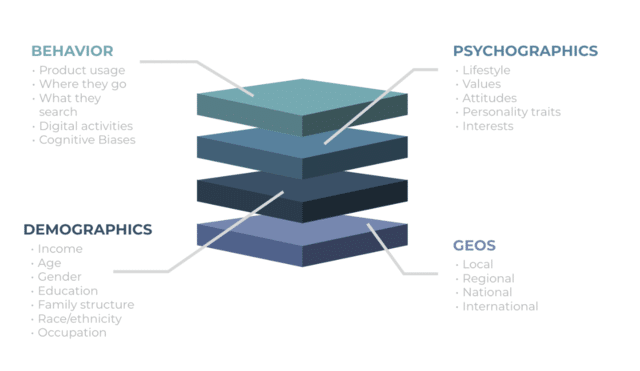
While developing multiple custom personas for all your degree programs may seem daunting and can be time consuming, the effort will pay off in the long run in terms of enrollment and student success.
Aligning all key stakeholders involved in developing and deploying the story and identity of a brand around key student personas is also critical to creating a more cohesive and clear experience for students throughout their journey. These personas should inform and influence all teams and stakeholders in their strategies — from paid media ads and targeting, to blog content, to website copy and landing pages, to nurture campaigns. No matter where students are in their educational journey, having a seamless experience across all channels and touch points is more important than ever before.
Utilizing various forms of primary and secondary research in the form of interviews, focus groups, market research, historical student data, and more, we at Archer Education are able to craft a deeper and more comprehensive understanding of what prospective students care about and how to most effectively reach and engage with them.
Here are the steps for getting started.
Conducting Persona Research and Development
Whether your enrollment marketing team does the research itself or relies on secondary sources (we suggest using a combination of both) the information-gathering process for developing student personas is essentially the same. Enrollment marketers will want to begin by gathering a lot of information from a lot of sources. At Archer, our go-to tactics and sources include:
Conduct Discovery Interviews
Interviews with key university stakeholders including program directors, enrollment/admissions teams, faculty, alumni, and current students are an important source of information for understanding student aspirations and goals, challenges and pain points, and even lifestyle circumstances.
We recommend speaking with as many stakeholders as possible to gather diverse insights and perspectives through one-on-one discussions, group interviews, and focus groups to inform robust student personas. The interviewer’s goals are to:
- Learn who students are by gathering demographic and psychographic data. (Psychographics focuses on understanding students’ values, goals, interests, and emotions to gain a complete and accurate picture of them as individuals.)
- Discover why students want to enroll in a particular program.
- Explore why they’re attracted to a particular institution.
- Learn what challenges or pain points they face.
- Find out what they want to accomplish after graduation.
Stories and examples gathered during interviews with current students and alumni about how your program helped them achieve their educational or career goals are especially effective for connecting with prospective students.
Mine Historical Student Data
Existing student demographic data (if available) including age, gender, prior education (degree type and level), and job title can help provide very tangible and relevant information for student personas. Institutions that consistently track and report data have an advantage, while brand-new programs that lack historical data may need to lean more heavily on other sources. Student or alumni reports or survey results, if available, can provide great supplemental information for getting to know prospective, current, and former students better.
Conduct Market Research
Many students today, and nontraditional/adult learners in particular, are hyper-focused on outcomes and looking for a return on investment in their chosen degree program. Marketing tools and resources enrollment marketers can use to make their program’s case to prospective students include:
- Government data on job growth and salaries from the U.S. Bureau of Labor Statistics
- Insights from Lightcast (formerly Emsi Burning Glass), an aggregator of economic, labor market, demographic, education, profile, and job posting data
- Industry-specific articles that highlight opportunities and motivate students to enroll
Leverage Audience Intelligence Tools
The ability to gather insights into audiences through social listening and other data sources — known as audience intelligence — is gaining traction with marketers as tools become more advanced. At Archer, one tool that our team uses is Sparktoro, an audience research tool that crawls millions of social profiles and web pages to learn what (and who) your audience reads, listens to, watches, follows, shares, and talks about online. This is a helpful supplemental tool that can help provide a clearer picture of your audiences across various data points and attributes.
If you’re not in a position to pay for audience intelligence tools, some free ones are available like CareerOneStop, which is sponsored by the U.S. Department of Labor. This tool is more limited to demographic information, but it can be helpful for learning more about certain industries or occupations that relate to a given student persona.
Facebook Audience Insights is another free tool that we have leveraged in the past to gain a better understanding of users connected to our partners’ pages, as well as to learn about the interests and affinities of a given audience. The tool has become more limited as Facebook has tightened up their access to users’ data and profile attributes, but it still may be worth checking out — especially if Facebook is one of your primary marketing channels.
Synthesizing Research and Outlining Personas
When discovery interviews are complete and market, audience, and other research has been gathered, it’s time to begin synthesizing what you’ve found and outlining your data-informed personas.
Depending on the scope of your project and goals, the structure and template you decide to use for personas may look quite different. Personas developed for the entire graduate school of an institution, for example, will probably look very different from personas created for one specific program. Regardless of the scope and subsequent approach, you should ensure that you’ve covered your bases across the spectrum of core audiences while trying to make each as distinct as possible from one another — either in terms of shared interests and goals, or in terms of demographic factors such as incoming occupation (like being a working nurse) or lifestyle circumstances (like being a stay-at-home parent returning to school).
Once you’ve identified the distinct student personas you’ll want to focus on, it’s time to build them out in greater detail. The more in-depth information you’ve gathered, the easier it will be to create distinct, detailed personas that are applicable. When creating personas, make sure to honor your institution’s commitment to diversity, equity, and inclusion by representing students of different races, ethnicities, gender identities, and abilities. Don’t let your personas reinforce stereotypes.
There are many different templates and approaches you can use to develop personas — and there is no “right” way. Again, it really depends on your specific goals and how you can make the personas as applicable and actionable as possible. At Archer, our teams find that including areas like skills, interests, incoming occupations, age, education, media usage, and more are important. Also, we highly recommend including a “story” section (as in the examples below) to humanize your fictional student and create a clearer picture of who this persona is and what they care about.
Student Persona Examples
When we are tasked with creating personas across multiple programs and verticals, we like to create a persona architecture with overarching personas and subpersonas so we can plug them in across various programs, depending on our partner’s needs and goals. This gives our enrollment marketing teams options to target student personas on a broader or more granular level, depending on what makes most sense for the program.
The example below features overarching personas for a mix of tech/coding bootcamp programs with detailed subpersonas for each target beneath.
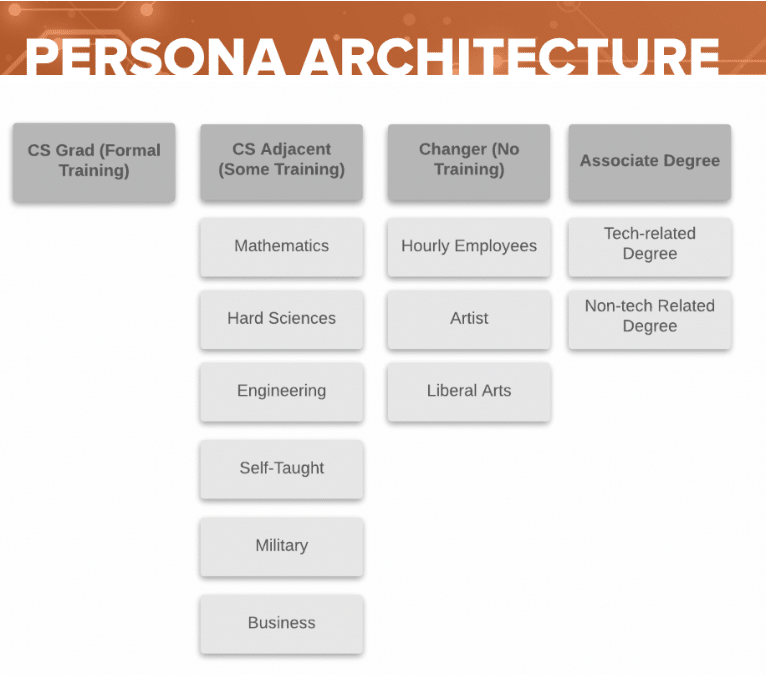
Technology is a broad field with opportunities for individuals who come in with a diverse mix of experience, education, interests, and skills. Developing a broader overarching persona (with sub-personas underneath) can help provide a high-level snapshot into a broader group of individuals who still share important commonalities. You can include things like an overview and some of the top motivations that are most relevant to that audience, in addition to other elements that help showcase who this audience is and what they care about.
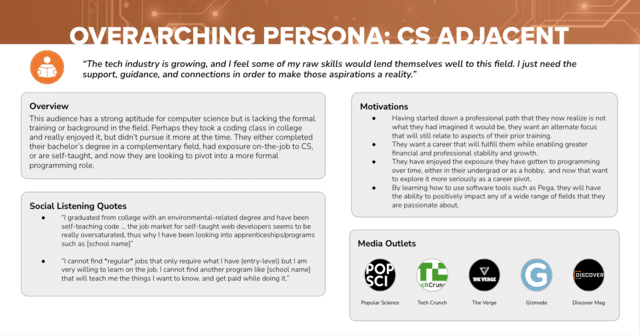
Then drill down using the data and stories you’ve collected in your research to animate your multiple subpersonas. Below are two subpersonas we’ve created for a partner’s tech bootcamp degree program.
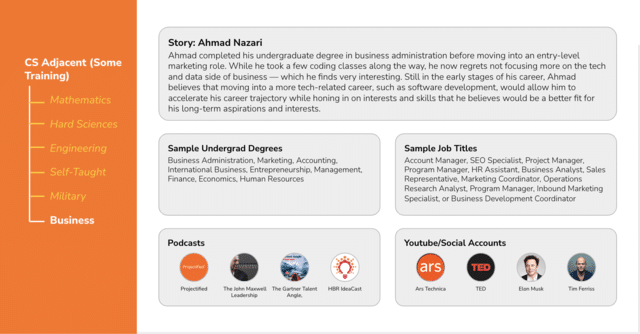
The next example below is a program-specific persona created for a single degree program. Programmatic personas typically include more in-depth and detailed information than personas designed to encompass more than one program. Notice the inclusion of sample job titles and skills.
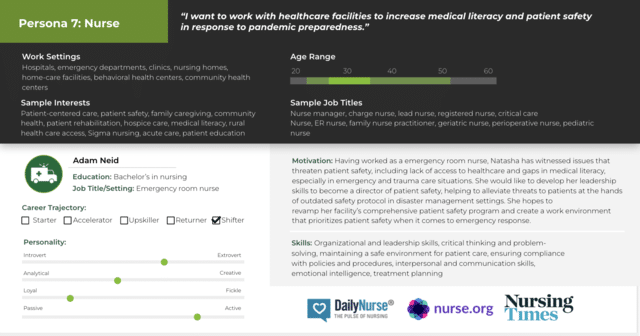
Developing student personas will not only help your institution attract the right students, it will help your marketing teams, enrollment specialists, and administrators identify and better understand your students’ needs and goals — a win-win for educators and students alike.
Creating Personas to Drive Enrollment
Persona-based marketing is a tried-and-true tool for customer acquisition, and higher education is no exception. When exploring colleges or degree programs, students want to know which one will be a good fit for them. Recognizing themselves in your marketing materials can make the difference between their moving forward in the enrollment funnel and moving on to a competitor.
At Archer Education, we partner with dozens of institutions to craft story-driven, persona-based approaches to student acquisition. Request more information and see what Archer can do to help you connect with and enroll the right students.


